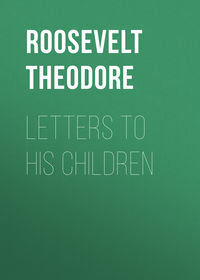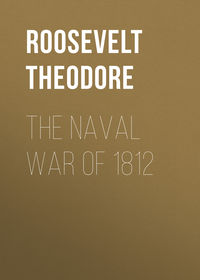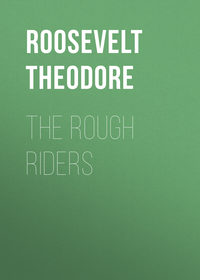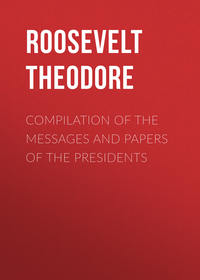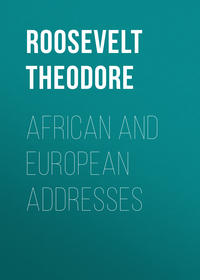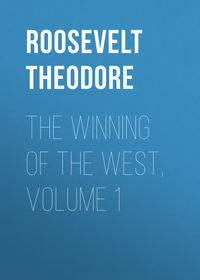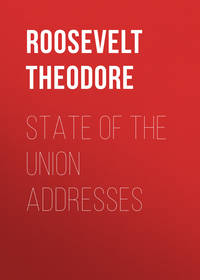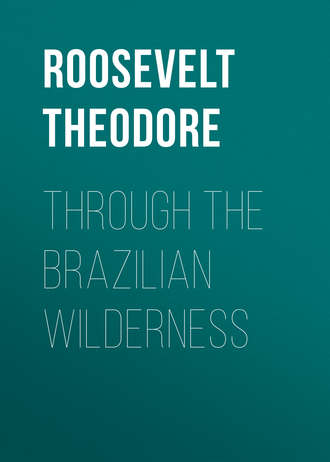 полная версия
полная версияThrough the Brazilian Wilderness
On the afternoon of February 15 we reached Campos Novos. This place was utterly unlike the country we had been traversing. It was a large basin, several miles across, traversed by several brooks. The brooks ran in deep swampy valleys, occupied by a matted growth of tall tropical forest. Between them the ground rose in bold hills, bare of forest and covered with grass, on which our jaded animals fed eagerly. On one of these rounded hills a number of buildings were ranged in a quadrangle, for the pasturage at this spot is so good that it is permanently occupied. There were milch cows, and we got delicious fresh milk; and there were goats, pigs, turkeys, and chickens. Most of the buildings were made of upright poles with roofs of palm thatch. One or two were of native brick, plastered with mud, and before these there was an enclosure with a few ragged palms, and some pineapple plants. Here we halted. Our attendants made two kitchens: one was out in the open air, one was under a shelter of ox-hide. The view over the surrounding grassy hills, riven by deep wooded valleys, was lovely. The air was cool and fresh. We were not bothered by insects, although mosquitoes swarmed in every belt of timber. Yet there has been much fever at this beautiful and seemingly healthy place. Doubtless when settlement is sufficiently advanced a remedy will be developed. The geology of this neighborhood was interesting—Oliveira found fossil tree-trunks which he believed to be of cretaceous age.
Here we found Amilcar and Mello, who had waited for us with the rear- guard of their pack-train, and we enjoyed our meeting with the two fine fellows, than whom no military service of any nation could produce more efficient men for this kind of difficult and responsible work. Next morning they mustered their soldiers, muleteers, and pack- ox men and marched off. Reinisch the taxidermist was with them. We followed in the late afternoon, camping after a few miles. We left the oxcart at Campos Novos; from thence on the trail was only for pack- animals.
In this neighborhood the two naturalists found many birds which we had not hitherto met. The most conspicuous was a huge oriole, the size of a small crow, with a naked face, a black-and-red bill, and gaudily variegated plumage of green, yellow, and chestnut. Very interesting was the false bellbird, a gray bird with loud, metallic notes. There was also a tiny soft-tailed woodpecker, no larger than a kinglet; a queer humming-bird with a slightly flexible bill; and many species of ant-thrush, tanager, manakin, and tody. Among these unfamiliar forms was a vireo looking much like our solitary vireo. At one camp Cherrie collected a dozen perching birds; Miller a beautiful little rail; and Kermit, with the small Luger belt-rifle, a handsome curassow, nearly as big as a turkey—out of which, after it had been skinned, the cook made a delicious canja, the thick Brazilian soup of fowl and rice than which there is nothing better of its kind. All these birds were new to the collection—no naturalists had previously worked this region—so that the afternoon's work represented nine species new to the collection, six new genera, and a most excellent soup.
Two days after leaving Campos Novos we reached Vilhena, where there is a telegraph station. We camped once at a small river named by Colonel Rondon the "Twelfth of October," because he reached it on the day Columbus discovered America—I had never before known what day it was!—and once at the foot of a hill which he had named after Lyra, his companion in the exploration. The two days' march—really one full day and part of two others—was through beautiful country, and we enjoyed it thoroughly, although there were occasional driving rain- storms, when the rain came in almost level sheets and drenched every one and everything. The country was like that around Campos Novos, and offered a striking contrast to the level, barren, sandy wastes of the chapadao, which is a healthy region, where great industrial centres can arise, but not suited for extensive agriculture as are the lowland flats. For these forty-eight hours the trail climbed into and out of steep valleys and broad basins and up and down hills. In the deep valleys were magnificent woods, in which giant rubber-trees towered, while the huge leaves of the low-growing pacova, or wild banana, were conspicuous in the undergrowth. Great azure butterflies flitted through the open, sunny glades, and the bellbirds, sitting motionless, uttered their ringing calls from the dark stillness of the columned groves. The hillsides were grassy pastures or else covered with low, open forest.
A huge frog, brown above, with a light streak down each side, was found hiding under some sticks in a damp place in one of the improvised kitchens; and another frog, with disks on his toes, was caught on one of the tents. A coral-snake puzzled us. Some coral- snakes are harmless; others are poisonous, although not aggressive. The best authorities give an infallible recipe for distinguishing them by the pattern of the colors, but this particular specimen, although it corresponded exactly in color pattern with the description of the poisonous snakes, nevertheless had no poison-fangs that even after the most minute examination we could discover. Miller and one of the dogs caught a sariema, a big, long-legged, bustard-like bird, in rather a curious way. We were on the march, plodding along through as heavy a tropic downpour as it was our ill fortune to encounter. The sariema, evidently as drenched and uncomfortable as we were, was hiding under a bush to avoid the pelting rain. The dog discovered it, and after the bird valiantly repelled him, Miller was able to seize it. Its stomach contained about half a pint of grass-hoppers and beetles and young leaves. At Vilhena there was a tame sariema, much more familiar and at home than any of the poultry. It was without the least fear of man or dog. The sariema (like the screamer and the curassow) ought to be introduced into our barnyards and on our lawns, at any rate in the Southern States; it is a good-looking, friendly, and attractive bird. Another bird we met is in some places far more intimate, and domesticates itself. This is the pretty little honey-creeper. In Colombia Miller found the honey-creepers habitually coming inside the houses and hotels at meal-times, hopping about the table, and climbing into the sugar-bowl.
Along this part of our march there was much of what at a hasty glance seemed to be volcanic rock; but Oliveira showed me that it was a kind of conglomerate, with bubbles or hollows in it, made of sand and iron- bearing earth. He said it was a superficial quaternary deposit formed by erosion from the cretaceous rocks, and that there were here no tertiary deposits. He described the geological structure of the lands through which we had passed as follows: The pantanals were of Pleistocene age. Along the upper Sepotuba, in the region of the rapids, there were sandstones, shales, and clays of Permian age. The rolling country east of this contained eruptive rocks—a porphyritic disbase, with zeolite, quartz, and agate of Triassic age. With the chapadao of the Parecis plateau we came to a land of sand and clay, dotted with lumps of sandstone and pieces of petrified wood; this, according to Oliveira, is of Mesozoic age, possibly cretaceous and similar to the South African formation. There are geologists who consider it as of Permian age.
At Vilhena we were on a watershed which drained into the Gy-Parana, which itself runs into the Madeira nearly midway between its sources and its mouth. A little farther along and northward we again came to streams running ultimately into the Tapajos; and between them, and close to them, were streamlets which drained into the Duvida and Ananas, whose courses and outlets were unknown. This point is part of the divide between the basins of the Madeira and Tapajos. A singular topographical feature of the Plan Alto, the great interior sandy plateau of Brazil, is that at its westernmost end the southward flowing streams, instead of running into the Paraguay as they do farther east, form the headwaters of the Guapore, which may, perhaps, be called the upper main stream of the Madeira. These westernmost streams from the southern edge of the plateau, therefore, begin by flowing south; then for a long stretch they flow southwest; then north, and finally northeast into the Amazon. According to some exceptionally good geological observers, this is probably due to the fact that in a remote geologic past the ocean sent in an arm from the south, between the Plan Alto and what is now the Andean chain. These rivers then emptied into the Andean Sea. The gradual upheaval of the soil has resulted in substituting dry land for this arm of the ocean and in reversing the course of what is now the Madeira, just as, according to these geologists, in somewhat familiar fashion the Amazon has been reversed, it having once been, at least for the upper two thirds of its course, an affluent of the Andean Sea.
From Vilhena we travelled in a generally northward direction. For a few leagues we went across the chapadao, the sands or clays of the nearly level upland plateau, grassy or covered with thin, stunted forest, the same type of country that had been predominant ever since we ascended the Parecis table-land on the morning of the third day after leaving the Sepotuba. Then, at about the point where the trail dipped into a basin containing the head-springs of the Ananas, we left this type of country and began to march through thick forest, not very high. There was little feed for the animals on the Chapadao. There was less in the forest. Moreover, the continual heavy rains made the travelling difficult and laborious for them, and they weakened. However, a couple of marches before we reached Tres Burity, where there is a big ranch with hundreds of cattle, we were met by ten fresh pack-oxen, and our serious difficulties were over.
There were piums in plenty by day, but neither mosquitoes nor sand-flies by night; and for us the trip was very pleasant, save for moments of anxiety about the mules. The loose bullocks furnished us abundance of fresh beef, although, as was inevitable under the circumstances, of a decidedly tough quality. One of the biggest of the bullocks was attacked one night by a vampire bat, and next morning his withers were literally bathed in blood.
With the chapadao we said good-by to the curious, gregarious, and crepuscular or nocturnal spiders which we found so abundant along the line of the telegraph wire. They have offered one of the small problems with which the commission has had to deal. They are not common in the dry season. They swarm during the rains; and, when their tough webs are wet, those that lead from the wire to the ground sometimes effectually short circuit the wire. They have on various occasions caused a good deal of trouble in this manner.
The third night out from Vilhena we emerged for a moment from the endless close-growing forest in which our poor animals got such scanty pickings, and came to a beautiful open country, where grassy slopes, dotted with occasional trees, came down on either side of a little brook which was one of the headwaters of the Duvida. It was a pleasure to see the mules greedily bury their muzzles in the pasturage. Our tents were pitched in the open, near a shady tree, which sent out its low branches on every side. At this camp Cherrie shot a lark, very characteristic of the open upland country, and Miller found two bats in the rotten wood of a dead log. He heard them squeaking and dug them out; he could not tell by what method they had gotten in.
Here Kermit, while a couple of miles from our tents, came across an encampment of Nhambiquaras. There were twenty or thirty of them—men, women, and a few children. Kermit, after the manner of honest folk in the wilderness, advanced ostentatiously in the open, calling out to give warning of his coming. Like surroundings may cause like manners. The early Saxons in England deemed it legal to kill any man who came through the woods without shouting or blowing a horn; and in Nhambiquara land at the present time it is against etiquette, and may be very unhealthy, to come through the woods toward strangers without loudly announcing one's presence. The Nhambiquaras received Kermit with the utmost cordiality, and gave him pineapple-wine to drink. They were stark naked as usual; they had no hammocks or blankets, and their huts were flimsy shelters of palm-branches. Yet they were in fine condition. Half a dozen of the men and a couple of boys accompanied Kermit back to our camp, paying not slightest heed to the rain which was falling. They were bold and friendly, good-natured—at least superficially—and very inquisitive. In feasting, the long reeds thrust through holes in their lips did not seem to bother them, and they laughed at the suggestion of removing them; evidently to have done so would have been rather bad manners—like using a knife as an aid in eating ice-cream. They held two or three dances, and we were again struck by the rhythm and weird, haunting melody of their chanting. After supper they danced beside the camp-fire; and finally, to their delight, most of the members of our own party, Americans and Brazilians, enthusiastically joined the dance, while the colonel and I furnished an appreciative and applauding audience. Next morning, when we were awakened by the chattering and screaming of the numerous macaws, parrots, and parakeets, we found that nearly all the Indians, men and women, were gathered outside the tent. As far as clothing was concerned, they were in the condition of Adam and Eve before the fall. One of the women carried a little squirrel monkey. She put it up the big tree some distance from the tents; and when she called, it came scampering to her across the grass, ran up her, and clung to her neck. They would have liked to pilfer; but as they had no clothes it was difficult for them to conceal anything. One of the women was observed to take a fork; but as she did not possess a rag of clothing of any kind all she did do was to try to bury the fork in the sand and then sit on it; and it was reclaimed without difficulty. One or two of the children wore necklaces and bracelets made of the polished wood of the tucum palm, and of the molars of small rodents.
Next day's march led us across a hilly country of good pastureland. The valleys were densely wooded, palms of several kinds being conspicuous among the other trees; and the brooks at the bottoms we crossed at fords or by the usual rude pole bridges. On the open pastures were occasional trees, usually slender bacaba palms, with heads which the winds had dishevelled until they looked like mops. It was evidently a fine natural cattle country, and we soon began to see scores, perhaps hundreds, of the cattle belonging to the government ranch at Tres Burity, which we reached in the early afternoon. It is beautifully situated: the view roundabout is lovely, and certainly the land will prove healthy when settlements have been definitely established. Here we revelled in abundance of good fresh milk and eggs; and for dinner we had chicken canja and fat beef roasted on big wooden spits; and we even had watermelons. The latter were from seeds brought down by the American engineers who built the Madeira Marmore Railroad—a work which stands honorably distinguished among the many great and useful works done in the development of the tropics of recent years.
Amilcar's pack-oxen, which were nearly worn out, had been left in these fertile pastures. Most of the fresh oxen which he took in their places were unbroken, and there was a perfect circus before they were packed and marched off; in every direction, said the gleeful narrators, there were bucking oxen and loads strewed on the ground. This cattle ranch is managed by the colonel's uncle, his mother's brother, a hale old man of seventy, white-haired but as active and vigorous as ever; with a fine, kindly, intelligent face. His name is Miguel Evangalista. He is a native of Matto Grosso, of practically pure Indian blood, and was dressed in the ordinary costume of the Caboclo—hat, shirt, trousers, and no shoes or stockings. Within the last year he had killed three jaguars, which had been living on the mules; as long as they could get mules they did not at this station molest the cattle.
It was with this uncle's father, Colonel Rondon's own grandfather, that Colonel Rondon as an orphan spent the first seven years of his life. His father died before he was born, and his mother when he was only a year old. He lived on his grandfather's cattle-ranch, some fifty miles from Cuyaba. Then he went to live in Cuyaba with a kinsman on his father's side, from whom he took the name of Rondon; his own father's name was DaSilva. He studied in the Cuyaba Government School, and at sixteen was inscribed as one of the instructors. Then he went to Rio, served for a year in the army as an enlisted man in the ranks, and succeeded finally in getting into the military school. After five years as pupil he served three years as professor of mathematics in this school; and then, as a lieutenant of engineers in the Brazilian army, he came back to his home in Matto Grosso and began his life-work of exploring the wilderness.
Next day we journeyed to the telegraph station at Bonofacio, through alternate spells of glaring sunshine and heavy rain. On the way we stopped at an aldea-village of Nhambiquaras. We first met a couple of men going to hunt, with bows and arrows longer than themselves. A rather comely young woman, carrying on her back a wickerwork basket, or creel, supported by a forehead band, and accompanied by a small child, was with them. At the village there were a number of men, women, and children. Although as completely naked as the others we had met, the members of this band were more ornamented with beads, and wore earrings made from the inside of mussel-shells or very big snail- shells. They were more hairy than the ones we had so far met. The women, but not the men, completely remove the hair from their bodies— and look more, instead of less, indecent in consequence. The chief, whose body was painted red with the juice of a fruit, had what could fairly be styled a mustache and imperial; and one old man looked somewhat like a hairy Ainu, or perhaps even more like an Australian black fellow. My companion told me that this probably represented an infusion of negro blood, and possibly of mulatto blood, from runaway slaves of the old days, when some of the Matto Grosso mines were worked by slave labor. They also thought it possible that this infiltration of African negroes might be responsible for the curious shape of the bigger huts, which were utterly unlike their flimsy, ordinary shelters, and bore no resemblance in shape to those of the other Indian tribes of this region; whereas they were not unlike the ordinary beehive huts of the agricultural African negroes. There were in this village several huts or shelters open at the sides, and two of the big huts. These were of closely woven thatch, circular in outline, with a rounded dome, and two doors a couple of feet high opposite each other, and no other opening. There were fifteen or twenty people to each hut. Inside were their implements and utensils, such as wicker baskets (some of them filled with pineapples), gourds, fire-sticks, wooden knives, wooden mortars, and a board for grating mandioc, made of a thick slab of wood inset with sharp points of a harder wood. From the Brazilians one or two of them had obtained blankets, and one a hammock; and they had also obtained knives, which they sorely needed, for they are not even in the stone age. One woman shielded herself from the rain by holding a green palm-branch down her back. Another had on her head what we at first thought to be a monkey-skin head- dress. But it was a little, live, black monkey. It stayed habitually with its head above her forehead, and its arms and legs spread so that it lay moulded to the shape of her head; but both woman and monkey showed some reluctance about having their photographs taken.
Bonofacio consisted of several thatched one-room cabins, connected by a stockade which was extended to form an enclosure behind them. A number of tame parrots and parakeets, of several different species, scrambled over the roofs and entered the houses. In the open pastures near by were the curious, extensive burrows of a gopher rat, which ate the roots of grass, not emerging to eat the grass but pulling it into the burrows by the roots. These burrows bore a close likeness to those of our pocket gophers. Miller found the animals difficult to trap. Finally, by the aid of Colonel Rondon, several Indians, and two or three of our men, he dug one out. From the central shaft several surface galleries radiated, running for many rods about a foot below the surface, with, at intervals of half a dozen yards, mounds where the loose earth had been expelled. The central shaft ran straight down for about eight feet, and then laterally for about fifteen feet, to a kind of chamber. The animal dug hard to escape, but when taken and put on the surface of the ground it moved slowly and awkwardly. It showed vicious courage. In looks it closely resembled our pocket gophers, but it had no pockets. This was one of the most interesting small mammals that we secured.
After breakfast at Bonofacio a number of Nhambiquaras—men, women, and children—strolled in. The men gave us an exhibition of not very good archery; when the bow was bent, it was at first held so that the arrow pointed straight upwards and was then lowered so that the arrow was aimed at the target. Several of the women had been taken from other tribes, after their husbands or fathers had been killed; for the Nhambiquaras are light-hearted robbers and murderers. Two or three miserable dogs accompanied them, half-starved and mangy, but each decorated with a collar of beads. The headmen had three or four wives apiece, and the women were the burden-bearers, but apparently were not badly treated. Most of them were dirty, although well-fed looking, and their features were of a low type; but some, especially among the children, were quite attractive.
From Bonofacio we went about seven miles, across a rolling prairie dotted with trees and clumps of shrub. There, on February 24, we joined Amilcar, who was camped by a brook which flowed into the Duvida. We were only some six miles from our place of embarkation on the Duvida, and we divided our party and our belongings. Amilcar, Miller, Mello, and Oliveira were to march three days to the Gy-Parana, and then descend it, and continue down the Madeira to Manaos. Rondon, Lyra, the doctor, Cherrie, Kermit, and I, with sixteen paddlers, in seven canoes, were to descend the Duvida, and find out whether it led into the Gy-Parana, our purpose was to return and descend the Ananas, whose outlet was also unknown. Having this in view, we left a fortnight's provisions for our party of six at Bonofacio. We took with us provisions for about fifty days; not full rations, for we hoped in part to live on the country—on fish, game, nuts, and palm-tops. Our personal baggage was already well cut down: Cherrie, Kermit, and I took the naturalist's fly to sleep under, and a very light little tent extra for any one who might fall sick. Rondon, Lyra, and the doctor took one of their own tents. The things that we carried were necessities—food, medicines, bedding, instruments for determining the altitude and longitude and latitude—except a few books, each in small compass: Lyra's were in German, consisting of two tiny volumes of Goethe and Schiller; Kermit's were in Portuguese; mine, all in English, included the last two volumes of Gibbon, the plays of Sophocles, More's "Utopia," Marcus Aurelius, and Epictetus, the two latter lent me by a friend, Major Shipton of the regulars, our military attaché at Buenos Aires.
If our canoe voyage was prosperous we would gradually lighten the loads by eating the provisions. If we met with accidents, such as losing canoes and men in the rapids, or losing men in encounters with Indians, or if we encountered overmuch fever and dysentery, the loads would lighten themselves. We were all armed. We took no cartridges for sport. Cherrie had some to be used sparingly for collecting specimens. The others were to be used—unless in the unlikely event of having to repel an attack—only to procure food. The food and the arms we carried represented all reasonable precautions against suffering and starvation; but, of course, if the course of the river proved very long and difficult, if we lost our boats over falls or in rapids, or had to make too many and too long portages, or were brought to a halt by impassable swamps, then we would have to reckon with starvation as a possibility. Anything might happen. We were about to go into the unknown, and no one could say what it held.


